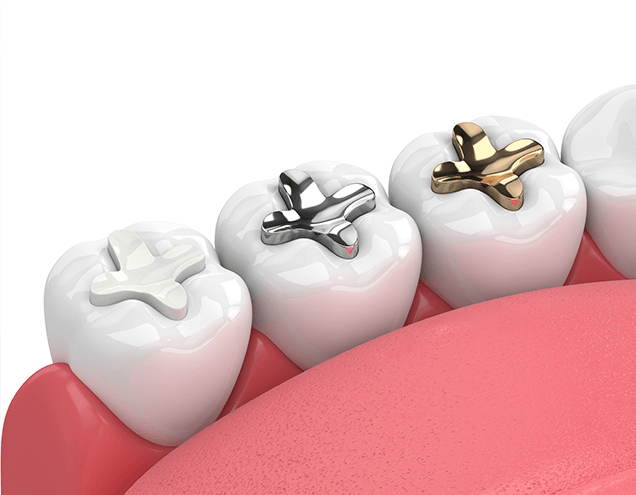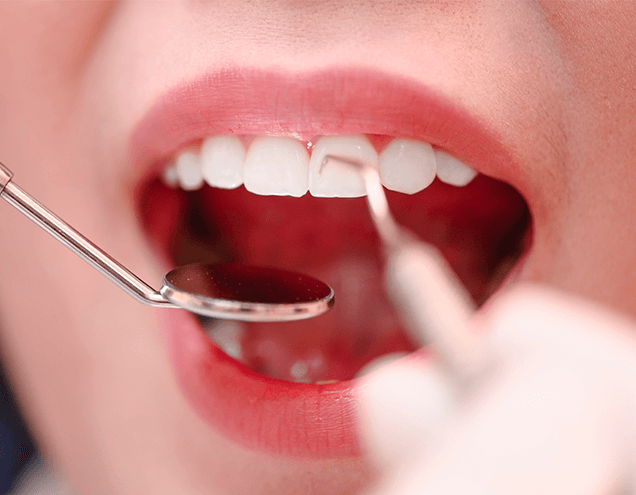

Dental fillings are a relatively quick, straightforward (simple, one-visit procedure) and an excellent option for restoring chipped, cracked, or decayed teeth. At Smile Arizona Dentistry, we provide natural-looking restoration options in Scottsdale, AZ and surrounding communities of Tempe, Mesa, and Phoenix to help our patients achieve a beautiful and healthy smile.
Request an Appointment Now!
Tooth-colored fillings offer a natural and aesthetic look by perfectly matching the color of your teeth. With these fillings, you can experience improved bite strength (if they are not too large or wide) and overall dental health. They are made of biocompatible materials like composite resin and silica fillers, so they are safe to use. They reflect some of the qualities of natural tooth structure such as translucency and wear resistance. Composites can help strengthen the tooth/teeth and minimize the possibilities of future damage.

We also offer these types of fillings to help you choose the one that matches your dental care needs.
A composite filling is made of resin and plastic and can be customized to match the color of your natural teeth. It is a perfect option for small-to-medium size restorations and can be used for cosmetic improvements such as enhancing the smile by changing the color of the teeth. These fillings need to be replaced typically every 2 to 10 years depending on the size of the repair, location in the mouth, diet (which can stain or discolor this type of restoration and/or the natural teeth requiring the desired improvement by replacement.)
A ceramic filling made of porcelain is tooth-colored and is more resistant to wear and stains compared to composite fillings. It is made in a dental laboratory (outside of the mouth), and this option can last longer, typically 5 to more than 15 years. It saves tooth structure because each time we replace a restoration, we need to fully clean out the tooth. A restoration that is replaced less frequently will help keep your tooth in function without requiring more invasive care sooner.
A resin filling features a combination of glass and acrylic, which is highly recommended for fillings in young children and below the gum line. Glass ionomers release fluoride, which protects the tooth from future damage. These fillings need to be replaced every 2 to 5 years.
Silver amalgam fillings are historically one of the most common filling materials. They are made of different metals, including copper, mercury, silver, zinc, and tin. This filling is durable, strong, and cost-effective. It can last for 10 to 15 years or more. However, it is rare that we use this type of filling material any more because one, it is not aesthetic, and can discolor teeth, two old amalgams commonly crack teeth, and third, although research shows the material is safe, many people feel very strongly about the contents in the materials. With all these reasons, we use the other options stated here, and it is very rare any dentist would choose to use an amalgam at this time.
If you have silver fillings in your mouth, ask about replacement choices, especially if you have had these fillings for a number of years. Amalgam fillings in themselves do not necessitate replacement per say, they have been a very successful choice of restorative material for decades.
Gold fillings are made of gold, copper, and other metal alloys. They are the most expensive fillings due to the cost of the metal compared to other types of fillings but last the longest. If you take good care of your oral health, it is common a gold restoration can last 50 years! The only negative of gold is the extra cost for the metal, and the color of the metal near the front of the mouth or in the “smile-zone” would not be most people's first choice!
Generally, one appointment is needed for a “filling”, but if a dental laboratory is involved say for a porcelain or gold option. Generally, you will be required to have two appointments to finish this care for “filling” your tooth. The duration and number of appointments for the dental filling procedure vary depending on the type of filling you choose, the number of teeth that need to be filled, the severity of your condition, and the size of the filling.
Our dental filling procedure includes these steps:
First, our dentist will examine the tooth that needs to be filled and take an X-ray film to check the extent of the damage and if there is any cavity or minor fracture. If these problems are not treated before placing the filling, they can cause an infection, pain, and further decay. You are typically given local anesthesia for preparing your tooth for a filling, so you feel a minimal sensation throughout this treatment.
Our dentist will start the procedure once you begin to feel the effects of anesthesia. We will remove the damage or decay of the tooth. After that, our dentist will check the area to determine whether all the damage and decay have been completely removed.
Now, our dentist will clean the bacteria and debris from the area to prepare it for the filling. An adhesive material is placed on your tooth to help the fillings blend well to the tooth. Depending on the extent of the decay, our dentist will apply the fillings in single or multiple layers. The curing light is used to harden the filling if you are having a composite/tooth-colored restoration placed.
Once the filling is applied, our dentist will shape it to the desired result to help it look nice and fit your bite, and then polish the filling. These things help your fillings look and feel natural. Our dentist will have you bite down to make sure the filling is in line with your remaining teeth and won't contribute to any issues when eating.

Signs that indicate you may require a tooth filling include:

The dental filling cost varies depending on the type of filling you choose, the severity of your condition, the number of teeth that need to be filled, and the size of the filling. However, at Smile Arizona Dentistry, we work with major insurance providers to help you cover as much treatment costs as possible.
We also accept major credit cards for all dental procedures and use lending sources GreenSky, CareCredit, and LendingUSA. Our office pays all or a portion of the fees associated with using this lending source. We want to help you have care TODAY and not wait for your condition(s) to worsen. We will make every possible effort to provide you affordable dental treatment choices. In fact, utilizing some dental “insurance” plans, dental care costs about 50% less today than it did even 5 years ago!
The durability of the dental fillings varies depending on the type of filling you choose. However, generally, a tooth filling lasts 2 to 5 years.
Tooth-colored fillings are popular dental fillings, as they can completely restore the cracked, chipped, or decayed teeth quickly and generally the most economically. They also improve the bite strength and oral functionality and provide a pleasing and aesthetic look to improve your smile. These fillings are made of biocompatible materials. Tooth-colored fillings can last for 2 to 10 years.
Decay makes your teeth weaker. We are halting decay and thus halting the weakening effects of decay, so no, fillings won’t make your teeth weaker. Instead, they provide additional support (less support than if your tooth never had a cavity though) to your teeth and protect them from further decay destruction and damage. If fillings are not properly placed or placed without treating the cavity or infection, it can lead to continued tooth decay or further dental problems and complications. Our dental team has years of experience and expertise in filling a tooth.
If you have an early sign of decay and no cavity or pain, you may not need a tooth filling. However, cavity fillings are required for decay that has developed over time, and decay always gets worse with time past what we call the incipient lesion stage. The best time to treat a cavity is immediately after the diagnosis. By the time you feel severe or a throbbing toothache, a filling will not treat this tooth. You would then need root canal treatment and usually a crown placement. The more treatment, expertise, and time required to treat a tooth, the cost increases.
If the cavity is not treated and filled on time, it can grow and cause further dental problems that may require a root canal treatment or tooth extraction. The cavity needs to be filled as soon as your dentist recommends it so that you can save your tooth.
The dental fillings won't hurt, as you are given anesthesia during the procedure to ensure that you are comfortable and feel no discomfort or pain. You may feel a small amount of sensitivity following the procedure once the anesthesia wears off, but it won't last long and will go away generally very quickly on its own.
A small filling can be completed in a few minutes, whereas a large filling can take an hour. The number of fillings that can be done in one sitting depends on the size of the filling required, the number of cavities that need to be filled, the amount of anesthetic required as well as the choice and convenience of the patient.
Click on the button below to request your dental appointment with Smile Arizona Dentistry today!